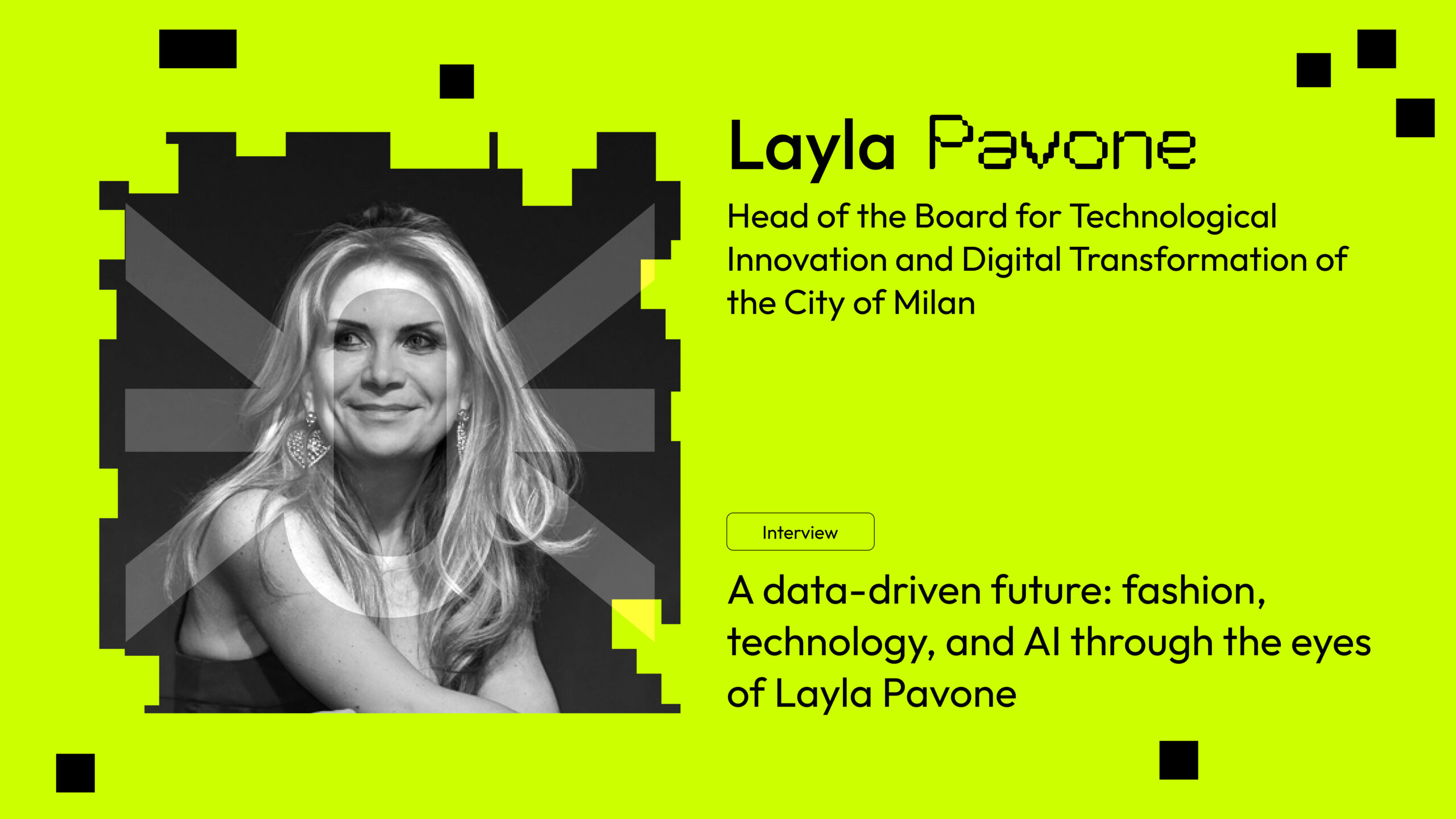A data-driven future: fashion, technology, and AI through the eyes of Layla Pavone

Today, we are joined by Prof. Layla Pavone, an expert in technological innovation and digital transformation. In this interview, we will discuss the impact of artificial intelligence on marketing and fashion, opportunities for start-ups, and the ethical challenges related to AI usage. We will also explore the initiatives Prof. Pavone is leading in Milan to promote a sustainable and inclusive digital transformation.
Could you tell us a bit about yourself and your professional journey? What led you to become a key figure in technological innovation and digital transformation, especially in a context like Milan?
Yes, of course. My career in digital began in the early 1990s, an exciting period when Italy was taking its first steps into the Internet era. In 1994, I was one of the founding members of Nicky Grauso’s team, which launched the first Internet Service Provider in Italy. This gave me a privileged position to observe and actively participate in the birth and evolution of digital technology in our country.
My academic background played a fundamental role in this journey. I graduated in Political Science and completed a master’s degree in Corporate Communication and New Technologies in 1988, a course that proved to be surprisingly ahead of its time, anticipating concepts and tools that would later become central in the digital world, such as desktop publishing.
My career has been characterized by the good fortune of being in the right place at the right time. I had the privilege of working closely with pioneers in the technology sector, gaining experiences that enriched my professional and personal background. Over the years, I have held various key roles, including that of CEO in a multinational communications company, where my main task was to develop the digital business, starting from online advertising, which at the time was largely uncharted territory.
My passion for innovation led me to explore beyond the boundaries of marketing and advertising. About fifteen years ago, I joined a start-up incubator, an experience that further broadened my perspectives, allowing me to delve into various innovation sectors, from sustainability to agritech and beyond. This phase of my career allowed me to contribute not only at a business level but also in terms of policies and strategies for technological innovation at a national and international level.
Today, my focus is on Milan, where I coordinate the Technological Innovation and Digital Transformation Board for the Municipality. This experience is particularly rewarding because it allows me to work on transformation projects that go beyond the purely technological realm, touching on social issues and public service innovation. For example, we are working on platforms that facilitate interaction between citizens and the administration, with the aim of making Milan a true smart city.
Could you elaborate on your view of artificial intelligence, particularly in the marketing and advertising sectors? Do you have any experience with start-ups or products that use AI in this area?
The advertising sector was one of the first to utilize artificial intelligence. Today, it is a highly discussed topic because it is current and of great interest, but AI has actually been used for many years. Just think of Amazon, which started sending product recommendations to its customers a long time ago. That is a classic example of AI applied to marketing.
Another significant example dates back to about 15 years ago, with the introduction of programmatic advertising, a technological innovation that radically changed the way online advertising spaces are bought and sold. Programmatic allowed for the regulation of supply and demand for advertising spaces through platforms that use artificial intelligence to manage the entire process, making predictions on user behavior much more accurate. This made online advertising one of the first sectors where AI was tested and widely used.
Today, almost everything that online advertising is capable of— from lookalike profiling to user segmentation—is made possible by artificial intelligence. Nonetheless, we are still at the beginning stages in terms of fully leveraging its potential. The latest frontier in this field is the ability to highly personalize the advertising experience and establish a direct relationship between the consumer and the brand. Artificial intelligence could recognize users’ consumption habits and create a true interaction, even through the use of avatars or other interactive technologies.
An example of this trend is IBM’s Watson, which began experimenting in this field a few years ago. However, despite the great potential of these technologies, we have not yet seen a real boom, probably due to the still very high costs. Effectiveness and efficiency are key elements in the advertising sector, and AI-based technologies require significant investments to be implemented on a large scale.
I know you don’t work directly in fashion, but do you have any observations on the application of artificial intelligence in this sector? Perhaps you have had experiences with start-ups or projects related to the fashion world?
That’s true, I’m not an expert in fashion, and I don’t work directly in this sector. However, thanks to my contacts and relationships, I’m aware of what is being done, especially in the academic world related to fashion. A significant example is the Istituto Marangoni and other similar schools, many of which are based in Milan, where fashion is a central theme.
In this context, artificial intelligence is already widely applied, especially by new designers. AI technologies are used to develop new materials and to create metaverses, thus offering a freer and more innovative space for expression. Moreover, these technologies allow for the involvement of new target audiences that would otherwise be very difficult to reach using traditional methods.
I believe that the most advanced and experimental fashion is already exploiting the potential of artificial intelligence. It would be desirable for these innovations to be adopted by major brands as well, although, as always, it is a matter of business. The more brands recognize the benefits of AI, the more we will see these technologies applied on a large scale. Artificial intelligence, in both its generative and machine learning forms, can have a significant impact on the fashion industry, not only at a creative level but also at an industrial one.
In the fashion sector, machine learning can improve the efficiency of production processes, in addition to creating new business opportunities and innovative models. If we look at the marketing side, AI offers extraordinary possibilities for content creation, storytelling, and the use of images—elements that are crucial for fashion brands. The opportunities are truly unprecedented, and this represents one of the greatest revolutions since the advent of the Internet, about thirty years ago.
Looking at the start-up world, in recent years we have witnessed a sort of revival of Silicon Valley, possibly driven by the growing focus on artificial intelligence. Which sectors are currently dominating the start-up landscape, and how do you identify truly valuable start-ups, distinguishing them from those merely following the trend?
From my perspective, we are witnessing a phase of reiteration, so to speak. After the initial excitement that swept through Silicon Valley and the start-up world in general, it seems we have now entered a period of greater reflection. In the digital sector, especially in digital marketing, we saw a real bubble emerge. Today, it is challenging to find true innovation in this field because many of the major breakthroughs have already been achieved.
However, the situation is different in other sectors, where artificial intelligence is genuinely making a difference. One example is biotech, where AI is driving significant innovations, as well as in the fashion industry, particularly through the use of new materials. These are sectors that offer great growth opportunities, where start-ups can truly add value.
Personally, I am fortunate to be able to explore various sectors, and I see that fintech and insurtech are also benefiting enormously from the introduction of artificial intelligence. AI allows for complex calculations to be performed in a fraction of the time and at a much lower cost than was previously possible, opening up new avenues for innovation.
Another field I find particularly interesting is health and life sciences, especially in pharmaceuticals and biotech. For example, AI is being used to analyze molecules and develop new drugs, or to make predictions about neurological diseases such as Alzheimer’s. I have personally invested in a start-up working precisely on this: searching for a molecule that could prevent Alzheimer’s.
As for marketing and advertising, I believe we have already seen most of the possible innovations. It’s a sector that is not yet fully mature, despite all the progress made. When we navigate online, we still notice outdated advertising models, such as basic pop-ups or banner ads, which do not fully exploit the potential of artificial intelligence. There is therefore a dichotomy between the innovative technologies that start-ups are developing and the extent to which the industry is actually adopting them.
I would like to ask your opinion on a topic I consider central: ethics in artificial intelligence. What concrete steps are you taking in Milan to raise public awareness on this issue, and how are you addressing the challenges related to copyright, ethics, and managing the problems that generative AI brings?
In Milan, we are working on two main fronts within the city’s strategic plan. The first is a strong focus on innovation, based on projects such as the Digital Twin and the urban digital ecosystem. The goal is to transform Milan into a data-driven city, surpassing the concept of a smart city. The idea is to integrate available data to create new business opportunities and improve services for citizens. For example, we have an open data portal with around two thousand datasets available, which companies can use to develop innovative solutions. But our real objective is to create an urban digital ecosystem where even private companies, such as telecommunications and utility companies, can share part of their data to contribute to the common good.
One concrete example is the complete digital mapping of the city of Milan, carried out with a high level of precision, to the point that we can monitor details such as an individual cobblestone. Through this system, we can control the real-time status of various urban infrastructures, such as outdoor dining areas, mobility, energy, and waste management. This project offers us endless possibilities to make the city more efficient and sustainable.
The other front we are working on is involving citizens, not only making them participants but also making them aware of what it means to live in a digital city. The big gap I see today is that, although everyone is connected and uses social media, there is a lack of deep understanding of what it means to be a digital citizen. Many industry professionals tend to be self-referential, assuming that the public is already aware of everything related to digital just because they are connected. But that is not the case: there is still no widespread awareness of crucial issues such as ethics, responsibility, and transparency, which are fundamental when we talk about artificial intelligence.
From the Milan administration’s side, we are putting a lot of effort into outreach and education. We organize neighborhood meetings, but we also use online tools to engage citizens, often in collaboration with private companies that provide their know-how for free. The public-private partnership model is a reality in Milan, and we work extensively with companies to educate citizens on topics like cybersecurity and the importance of being conscious digital citizens.
One of my main concerns is related to the risk that artificial intelligence, if not properly understood and managed, could bring problems into people’s homes that they may not yet be aware of. Just look at what has happened in the world of politics, especially in the United States and the United Kingdom, to see how dangerous AI can be if misused. This is a topic I constantly try to draw attention to because it is not something that can be addressed with a single training course. It is a continuous and structured process that requires an approach similar to advertising, with repeated messages that penetrate people’s minds and help them understand the importance of these issues.
We are also working to involve citizens directly in the design of digital services. We have a platform called “Milano Partecipa,” where citizens can collaborate with the administration through co-design workshops. This helps us build services that are truly useful and relevant to people, involving them in the decision-making process. In the future, we are also considering adopting an electronic registry of algorithms, where we will publish the algorithms we use and explain how they are employed and what impacts they have on citizens. This is a concrete example of how we want to ensure transparency and ethics in the use of artificial intelligence.
Our goal is to achieve “AI for good,” as the United Nations calls it. But to reach this outcome in a democratic society, we need to bring all citizens on board and make sure they fully understand the impact of artificial intelligence on their lives. Only then can we prevent a digital divide that could turn into an even greater AI divide, with potentially very serious political and social consequences.


